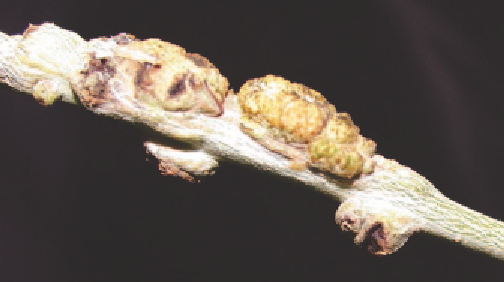Agriculture Reference
In-Depth Information
Fig 13.2 Olive knot symptoms on the branch of a mature tree.
Source of infection and spread
The bacteria live in the galls and the ooze from them
during wet weather. The bacteria are spread by water splash
and wind-driven rain. Infection occurs through wounds,
including leaf scars, pruning wounds and damage resulting
from harvesting, hail and frost. Trees are at greatest risk if
wounding occurs during wet weather. Long-distance
spread is usually through infected nursery stock.
Fig 13.4 Cut section of an olive knot gall.
Apply protective copper fungicide sprays after harvest
and in spring to protect young growth.
•
Importance
Olive knot is an important disease of olive worldwide.
While it occurs in several states in Australia, it is not yet
widespread. The disease can cause tree death if young tree
trunks are girdled by knots. Trees can also be weakened by
dieback of young branches and twig death.
Avoid harvesting and pruning before or during wet
weather.
•
Prune affected trees fi rst, burning affected wood
immediately.
•
Avoid over-fertilising, particularly with fertilisers
containing high nitrogen levels.
•
All commercial olive varieties are susceptible but
differences in susceptibility occur.
Maintain good hygiene by removing crop debris and
cleaning pruning equipment. Clean machinery entering
or leaving groves.
•
Management
•
Where infection is limited to only a few trees, remove and
burn infected trees to help limit spread.
Establish new groves with healthy stock.
•
Minimise wounding during pruning and complete
pruning well before wet spring weather.
•
FUNGI
ANTHRACNOSE
■
Cause
The fungus
Colletotrichum
sp.
Importance
Anthracnose can cause loss of mature fruit, particularly
during wet or humid weather. Refer to the chapter on
Common diseases of perennial fruit crops.
Fig 13.3 Close view of olive knot symptoms.













